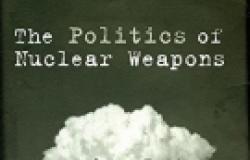Book Review: The Politics of Nuclear Weapons

The Politics of Nuclear Weapons by Andrew Futter. London and New Delhi: Sage, 2015. 280 pp, £75 hardcover 978-1-4462-9430-7, £26.99 paperback 978-1-4462-9431-4
A good textbook on nuclear weapons, one that synthesizes the vast research literature and complex policy debates, is not easy to find. The recently released Politics of Nuclear Weapons by Andrew Futter is an admirable attempt to fill the need for such an educational resource. While it could be improved, the book has many praiseworthy qualities.
This is Futter´s second single authored book and, despite its quite different area of focus from his previous monograph, it is primarily addressed to the same audience – advanced undergraduate and graduate students pursuing an academic perspective on the topic of nuclear weapons. At the book’s beginning, the author states that the content has been designed as an impartial and introductory guide serving as a “springboard” toward more specialized readings and deeper understanding of the issue at hand. Indeed, the educative and pedagogical character of the book is discernible throughout. The book offers a meaningful synthesis of a wide variety of facts and opinions on key issues concerning nuclear weapons. Succinctly yet accurately, Futter describes the early years of the development of nuclear weapons and nuclear strategies, discusses differences between vertical and horizontal proliferation, identifies the obstacles associated with managing nuclear proliferation and disarmament, and addresses the challenges related to the access of non-state actors to nuclear weapons.
An apt demonstration of the author´s effort to remain impartial can be found in the chapter on the proliferation debate. Futter engagingly examines both optimistic and pessimistic approaches toward nuclear proliferation through the lens of the Waltz-Sagan debate. In this debate, Waltz argues that nuclear weapons make war less likely, and that their possession produces deterrence, while Sagan maintains the opposite: nuclear weapons are making the world less stable and unsafe. Regrettably, Futter is reluctant to express his opinion on which school of thought he believes to be more persuasive. Instead, he contends that a nuclear latency remains one of the biggest proliferation challenges that the international community will face. The main problem is that the technology needed for a civilian nuclear program is very similar to the one needed to produce fissile material for a bomb. This conundrum is underpinned by the very character of the Non-Proliferation Treaty (NPT), granting all member states a right to produce their own peaceful nuclear energy. Because of this, countries can move fairly close to acquiring a nuclear breakout capacity without “actually undermining the NPT or breaking international law” (p. 62). This observation, though not particularly revolutionary, shrewdly sidesteps the Waltz-Sagan debate by emphasizing procedural and technical shortcomings of already existing non-proliferation measures.
Placing Futter´s argument under strict scrutiny, however, it can be deduced that even if the author is hesitant to take a side explicitly, his reasoning leans towards Sagan´s notion that the policy of non-proliferation is a more adequate way for reaching peace. This is also reflected by the fact that the book is permeated with references to the norms of non-proliferation, non-use, and a nuclear taboo.
Nonetheless, the aforementioned virtues of the book are simultaneously its Achilles’ heel. While it is virtually impossible to cover all relevant aspects of nuclear strategies in depth and breath, as well as to uncover all nooks and crannies hidden behind the politics of nuclear weaponry, the book primarily suffers from its short length: 214 pages are simply not enough to satisfactorily cover all interesting questions and topics outlined in the book. In chapter 3, for example, Futter addresses various factors leading countries to decide whether or not to “go nuclear”. The analysis is then framed by a simple, though ambitious, research question – why have states decided either to build or not to build a bomb? To adequately address such a bold query, one would say that four pages are simply not enough. Although Futter lists four models influencing a “going nuclear” decision (national security, domestic politics, norms, and technological determinism), they cannot—without deeper scrutiny—adequately provide answers to questions such as why the international community does not observe a nuclear spiral in the context of a security dilemma, or how the nexus between national security and norms of non-proliferation could affect a state´s decision to obtain a nuclear weapon.
The author also wonders about the reasons why nuclear-armed states have chosen not to use them against non-nuclear states. Similarly, the question of why countries that do not possess nuclear weapons have initiated war against nuclear-armed states despite them having these weapons also remains unanswered. While for nuclear-armed states nuclear non-use is underpinned by mutual assured destruction (MAD), the involvement of non-nuclear states renders MAD ineffective. In the explanation of this conundrum, Futter stresses the role of normative appeals and a concept of ‘nuclear taboo’ for turning countries away from the temptation to use nuclear weapons. However, this explanation is rather tenuous. It would be valuable if the author were to examine other factors keeping states out of nuclear wars. For instance, a cost-benefit calculation and the effect of enhanced conventional weapons should also be seen as important factors entering into the decision-making about whether or not to employ nuclear weapons.
In general, The Politics of Nuclear Weapons meets most requirements for serving as valuable material for undergraduate and graduate courses in IR and foreign policy. Indeed, some chapters, namely those on nuclear disarmament and the management of nuclear proliferation challenges, provide great insights about less known nuclear disarmament groups and treaties. However, it is really difficult to go into depth as the chapters are confined to around fifteen pages. The result is that chapters provide well-written and easily deliverable material, yet without detailed elaboration of pressing issues, such as negotiations about the Iranian nuclear program, along with scenarios of how the world’s strategic nuclear stability will change if Iran develops a nuclear weapon. In a similar vein, the author could have at least briefly touched upon the role of nuclear weapons in the recently deteriorating relations between Russia and the NATO countries over Ukraine. Despite its evolving character, some discussion of this interaction would infuse new blood into the extant body of literature on nuclear weapons.
There is no dispute that Futter´s commitment to impartiality and effort to avoid bias are laudable, especially with respect to student readers. But, taking into account the educative character of the textbook, I suggest that a more critically driven assessment with less overemphasis on neutrality would make the book more valuable, even for postgraduate students and professionals in the field.
Luboš Fendrych is a PhD student in Global Studies at the University of Massachusetts Lowell.


